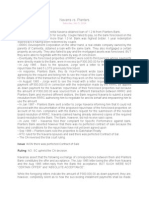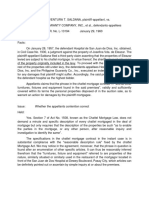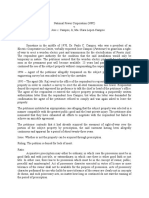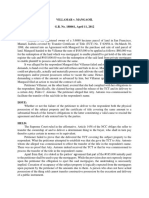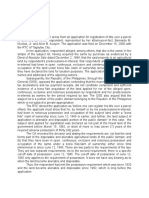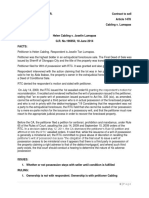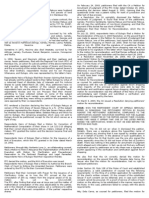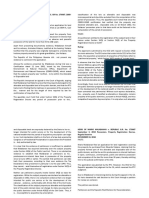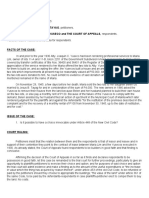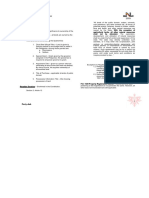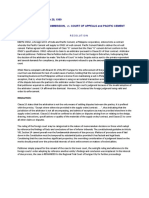Binalay Vs Manalo Digest
Binalay Vs Manalo Digest
Uploaded by
Milcah MagpantayCopyright:
Binalay Vs Manalo Digest
Binalay Vs Manalo Digest
Uploaded by
Milcah MagpantayOriginal Description:
Original Title
Copyright
Share this document
Did you find this document useful?
Is this content inappropriate?
Copyright:
Binalay Vs Manalo Digest
Binalay Vs Manalo Digest
Uploaded by
Milcah MagpantayCopyright:
BINALAY VS MANALO G.R. No.
92161 March 18, 1991
FACTS:
The late Judge Taccad originally owned a parcel of land situated in Tumauini, Isabela having an estimated area of twenty
(20) hectares. The western portion of this land bordering on the Cagayan River has an elevation lower than that of the
eastern portion which borders on the national road. Through the years, the western portion would periodically go under
the waters of the Cagayan River as those waters swelled with the coming of the rains. The submerged portion, however,
would re-appear during the dry season from January to August. It would remain under water for the rest of the year,
that is, from September to December during the rainy season.
The ownership of the landholding eventually moved from one person to another. On 9 May 1959, respondent Guillermo
Manalo acquired 8.65 hectares thereof from Faustina Taccad, daughter of Judge Juan Taccad.Later in 1964, respondent
Manalo purchased another 1.80 hectares from Gregorio Taguba who had earlier acquired the same from Judge Juan
Taccad. The second purchase brought the total acquisition of respondent Manalo to 10.45 hectares. The two (2) parcels
of land belonging to respondent Manalo were surveyed and consolidated into one lot. As the survey was conducted on a
rainy month, a portion of the land bought from Faustina Taccad then under water was left unsurveyed and was not
included in Lot 307.Considering that water flowed through the eastern branch of the Cagayan River when the cadastral
survey was conducted, the elongated strip of land formed by the western and the eastern branches of the Cagayan River
looked very much like an island. This strip of land was surveyed on 12 December 1969.
The big picture is this: Cagayan River running from south to north, forks at a certain point to form two braches (western
and eastern) and then unites at the other end, further north, to form a narrower strip of land. The eastern branch of the
river cuts through Lot 307, and is flooded during the rainy season. The unsurveyed portion, on the other hand, is the bed
of the eastern branch. Note that the fork exists only during the rainy season while the island elongated strip of land
formed in the middle of the forks becomes dry and perfect for cultivation when the Cagayan River is at its ordinary
depth. The strip of land in the middle of the fork totaled 22.7 hectares and was labeled Lot 821-822. Lot 821 is directly
opposite Lot 307 and is separated by the eastern branch of the river’s fork. Manalo claims that Lot 821 belongs to him by
way of accretion to the submerged portion of the land to which it is adjacent. Petitioners (Binalay, et al) who possess the
Lot 821, on the other hand, insist that they own it. They occupy the other edges of the lot along the river bank (i.e. the
fertile portions on which they plant tobacco and other agricultural products) and also cultivate the western strip during
the summer. Manalo filed 2 cases for forcible entry which were both dismissed. Later on, he filed a complaint for
quieting of title, possession, and damages against petitioner. The trial court and the CA ruled in favor of Manalo, saying
that Lot 821 and Lot 307 cannot be considered separate and distinct from each other. They reasoned that when the land
dries up for the most part of the year, the two are connected. [Note: The CA applied the ruling in Gov’t of the Phil
Islands vs. Colegio de San Jose, which was actually inappropriate because the subject matter in this case was a lake so
that the definition of a ‘bed’ was different.]
ISSUE:
Whether or not Manalo owns Lot 821 by way of accretion
RULING:
No. The disputed property is not an accretion. It is the action of the heavy rains that cause the highest ordinary level of
waters of the Cagayan River during the rainy season. The depressed portion is a river bed and is thus considered
property of public domain. The SC observed the following:
a) The pictures identified by Manalo during his direct examination depict the depressed portion as a river bed. The dried
up portion had dike-like slopes (around 8m) on both sides connecting it to Lot 307 and Lot 821 that are vertical and very
prominent.
b) The eastern bed already existed even before Manalo bought the land. It was called Rio Muerte de Cagayan.
c) Manalo could not have acquire ownership of the land because article 420 of the civil code states that rivers are
property of public dominion. The word river includes the running waters, the bed, and the banks. [The seller never
actually owned that part of the land since it was public property]
d) The submerged area (22.72 ha) is twice the area of the land he actually bought. It is difficult to suppose that such a
sizable area could have been brought about by accretion.
More importantly, the requisites of accretion in article 457 were not satisfied. These are:
1) that the deposition of the soil or sediment be gradual and imperceptible;
2) that it be the result of the action of the waters of the river (or sea); and
3) the land where the accretion takes place is adjacent to the banks of the rivers (or the sea coast).
The accretion should have been attached to Lot 307 for Manalo to acquire its ownership. BUT, the claimed accretion lies
on the bank of the river; not adjacent to Lot 307 but directly opposite it -across the river. Aside from that, the dike-like
slopes which were very steep may only be formed by a sudden and forceful action like flooding. The steep slopes could
not have been formed by the river in a slow and gradual manner.
You might also like
- 13 PEOPLE OF THE PHILIPPINES Vs CHI CHAN LIU and HUI LAO CHUNG 1100% (1)13 PEOPLE OF THE PHILIPPINES Vs CHI CHAN LIU and HUI LAO CHUNG 12 pages
- Hilario vs. The City of Manila G.R. No. L-19570, April 27, 1967 FactsNo ratings yetHilario vs. The City of Manila G.R. No. L-19570, April 27, 1967 Facts1 page
- 9) 13 Phil 152 - GR 5013 - Harty v. Municipality of Victoria100% (1)9) 13 Phil 152 - GR 5013 - Harty v. Municipality of Victoria4 pages
- Torres Case and Goldenway Merchandising CaseNo ratings yetTorres Case and Goldenway Merchandising Case6 pages
- Ruben Reyes vs. Tang Soating (Joanna Tang) and Ando G. Sy G.R. No. 185620No ratings yetRuben Reyes vs. Tang Soating (Joanna Tang) and Ando G. Sy G.R. No. 1856202 pages
- Velez vs. Velez, G.R. No. 187987, November 26, 2014No ratings yetVelez vs. Velez, G.R. No. 187987, November 26, 20143 pages
- 003 NPC v. Campos, GR 143643 June 27, 2003No ratings yet003 NPC v. Campos, GR 143643 June 27, 20032 pages
- Prado v. Caballero (G.R. No. 148225, March 3, 2010)No ratings yetPrado v. Caballero (G.R. No. 148225, March 3, 2010)2 pages
- G.R. No. 176492 October 20, 2014 MARIETTA N. BARRIDO, Petitioner, LEONARDO V. NONATO, RespondentNo ratings yetG.R. No. 176492 October 20, 2014 MARIETTA N. BARRIDO, Petitioner, LEONARDO V. NONATO, Respondent3 pages
- Navy Officers Village Association Inc. Novai Petitioner v. Republic of The Philippines RespondentNo ratings yetNavy Officers Village Association Inc. Novai Petitioner v. Republic of The Philippines Respondent26 pages
- Tuatis vs. Spouses Eliseo and Visminda Escol G.R. No. 175399 FactsNo ratings yetTuatis vs. Spouses Eliseo and Visminda Escol G.R. No. 175399 Facts3 pages
- Director of Lands vs. Register of Deeds of RizalNo ratings yetDirector of Lands vs. Register of Deeds of Rizal2 pages
- Republic of The Philippines v. Guzman 326 SCRA 90 FactsNo ratings yetRepublic of The Philippines v. Guzman 326 SCRA 90 Facts1 page
- (CD) Bicera vs. Teneza - G.R. No. L-16218 - November 29, 1962 - InternetNo ratings yet(CD) Bicera vs. Teneza - G.R. No. L-16218 - November 29, 1962 - Internet1 page
- Republic V. Court of Appeals 281 SCRA 639No ratings yetRepublic V. Court of Appeals 281 SCRA 6393 pages
- Gonzalez La O vs. Yek Tong Lin Fire & Marine Ins. Co.No ratings yetGonzalez La O vs. Yek Tong Lin Fire & Marine Ins. Co.2 pages
- Case Digest - G.R. No. L-8139 October 24, 1955No ratings yetCase Digest - G.R. No. L-8139 October 24, 19551 page
- Bank of The Philippine Islands v. Court of Appeals GR No. 116792, March 29, 1996 Ponente: Puno, J. Facts100% (1)Bank of The Philippine Islands v. Court of Appeals GR No. 116792, March 29, 1996 Ponente: Puno, J. Facts1 page
- R 13 PEOPLE OF THE PHILIPPINES Vs CHI CHAN LIU and HUI LAO CHUNG 1No ratings yetR 13 PEOPLE OF THE PHILIPPINES Vs CHI CHAN LIU and HUI LAO CHUNG 12 pages
- 60 STATE INVESTMENT HOUSE INC Vs CITIBANKNo ratings yet60 STATE INVESTMENT HOUSE INC Vs CITIBANK2 pages
- 5CD First Integrated Bonding Vs HernandoNo ratings yet5CD First Integrated Bonding Vs Hernando1 page
- Epublic of The Hilippines: Supreme CourtNo ratings yetEpublic of The Hilippines: Supreme Court20 pages
- North Woods & Waters National Heritage Area Feasibility StudyNo ratings yetNorth Woods & Waters National Heritage Area Feasibility Study276 pages
- Chapter 1 BASIC CONCEPT OF HYDROLOGY PDFNo ratings yetChapter 1 BASIC CONCEPT OF HYDROLOGY PDF20 pages
- Pavement Design Concepts-Flexible PavementsNo ratings yetPavement Design Concepts-Flexible Pavements3 pages
- List of Companies Dealing in Marine Products0% (1)List of Companies Dealing in Marine Products2 pages
- Notice of Intention To Rework / Redrill Well: Detailed Instructions Can Be Found atNo ratings yetNotice of Intention To Rework / Redrill Well: Detailed Instructions Can Be Found at2 pages
- Levels of Cultural Participation On The Deterioration of The Dumagats' Indeginous Culture in Sitio Karahume City of San Jose Del Monte, Bulacan 2008No ratings yetLevels of Cultural Participation On The Deterioration of The Dumagats' Indeginous Culture in Sitio Karahume City of San Jose Del Monte, Bulacan 200889 pages
- Dale Jensen, Program Manager: Spill Prevention, Preparedness & Response Program ECOPARK Session May 24, 2010No ratings yetDale Jensen, Program Manager: Spill Prevention, Preparedness & Response Program ECOPARK Session May 24, 201033 pages
- Model Bankable Project - Greenhouse Farming100% (1)Model Bankable Project - Greenhouse Farming13 pages
- "Advantages of Nursery Raising in Vegetable ProductionNo ratings yet"Advantages of Nursery Raising in Vegetable Production44 pages





